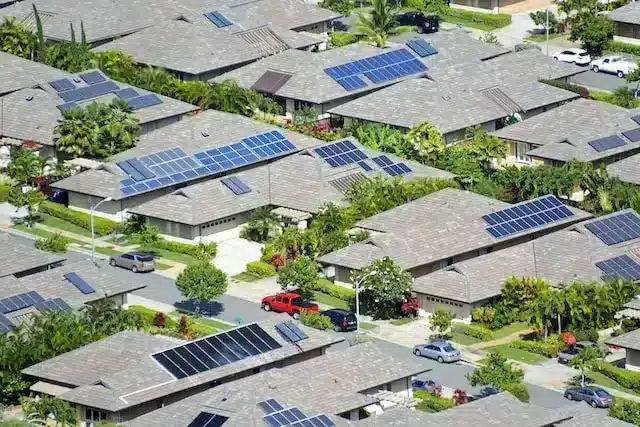
Solar AC and DC disconnects are an extremely important part of any grid-tied solar PV system since they allow for power coming from PV arrays to quickly be disconnected for safety in the event of a fire or other electrical issue.
Most building codes in North America require these disconnects to be in place within solar installations for safety, so being aware of how these switches work as well as their requirements is information that any solar professional or interested homeowner should know. Read on to learn everything you need to know about solar disconnects from how they work, why they’re important, and what their individual uses and requirements are.
AC and DC disconnects in solar. Why are they important?
Solar disconnects, also known as double safety disconnects, are an important element of any safe and working solar system, yet many homeowners are unaware they even exist until they get far into their quoting/installation process if they ever hear of them at all.
In the event of a fire, leaving a solar system tied to the grid could cause serious issues for firefighters and other users of the same grid. Electrical fires are extremely dangerous, after all. This is why firefighters need a quick and easy way to cut the power to and from your home, and also from your solar panels. This is where AC and DC disconnects come in handy.
Not only are solar disconnects important in case of emergency, but also provide a quick and easy way to kill the power to and from a building for solar system maintenance, utility operations, or as a preventative measure in case of a large storm that has the potential to be destructive. Basically, solar disconnects are simply “off” switches for solar systems.
Most building codes in the United States require that AC and DC disconnects are installed alongside solar systems. While each state may have different requirements, they all state that they must be located in areas that are easy to access, either outside the home or in a common area, and must fully disconnect the system from all other buildings or structures.
Some states, such as California, also take this a step further and include rapid shutdown requirements at the module level, which cut the power for each module individually, rather than on an array level when the AC disconnect switch is flipped.
DC Disconnect Requirements and Use
Also known as the PV disconnect, or Array DC disconnects, DC disconnects can either be placed directly inside the inverter, which is the small box responsible for converting your power from DC (direct current) to AC (alternating current), or between the inverter and the solar system.
Flipping the DC disconnect will effectively kill the power between the solar panels and the home in under 10 seconds. This is important because even if the inverter itself is shut off, the wires between the inverter and the solar system will still be live and coursing with power as long as the sun is hitting the solar panels, which is very dangerous for first responders in the event of a fire. This will also prevent any further damage to the home’s interior wiring in the case of a storm or other event.
The National Electrical Code (NEC), published by the National Fire Protection Association (NFPA), and updated every three years, requires DC disconnects to either be located inside the inverter, as many are today, or “within sight” of the inverter, making them easier to spot in an emergency, or simply for the system to be serviced while no one is home to show the technician where it is.
It’s important to note that while the NEC has been adopted by all 50 states as a way to standardize safe electrical practices all over the country, following the guidelines is not mandated by the law.
AC Disconnect Requirements and Use
AC disconnects, on the other hand, are usually found near the electric meter and prevent any further incoming power to the home from the grid. When solar systems are grid-tied, as most are, the home is still receiving power from the grid when the solar panels aren’t providing enough energy to power the home on their own.
This means that in the event of an emergency, that power must be cut to prevent any further damage to the home and solar system. They also must be quick and easy for emergency crews, solar installers, and homeowners alike to access and flip on or off when necessary.
AC disconnects come in handy in the case of fire since they will stop electricity from entering the home from the grid, both lowering the chances of the fire spreading at an increased pace, as well as protecting emergency crews from the risk of electrocution. They also provide a quick way to disconnect power when the grid is being serviced for any reason as a safety measure.
According to the NEC, AC disconnects must be easily accessible from the outside of the home, must be clearly marked, and it must be obvious to anyone looking at it that the switch is in an on or off position.
How to Size Solar AC and DC Disconnects
Sizing your solar disconnects comes down to the load size of the PV system in question. Generally speaking, the NEC states that the size of the disconnects should be based on the output rating of the inverter used. This, in turn, is based on the voltage, circuit load, amps and breaker size, and the wiring/cable sizes.
When designing a solar system for a homeowner, it’s important to look at each element individually, as well as how everything fits together to ensure that the system is performing properly and safely. Additionally, properly sizing a system will ensure that your client doesn’t end up overpaying for their system, or worse, receiving a quote for a system that is too small for their needs.
Proper sizing is also important when it comes to applying for permits for systems, especially if you would prefer not to have to deal with endless revisions and resubmissions. Disconnects can be larger than needed by the system but not smaller. For example, even if the system only needs a 30 amp box, a 60 amp would also be acceptable, as long as the correct wire size is accepted by the disconnect box.
In Closing
Solar disconnects are often left out of the conversation when it comes to discussing solar PV systems, even though they are one of the most useful and important safety measures in use to protect homeowners and firefighters from disaster.
Using Solargraf, solar professionals can quickly size their solar projects and include AC and DC disconnects in a few clicks, making system design and ordering solar permits a breeze. Book your free demo to learn more about all the features Solargraf has available to help cut your solar sales and design process down to under 15 minutes today.



 United States
United States Germany/Austria
Germany/Austria Brazil
Brazil Netherlands
Netherlands